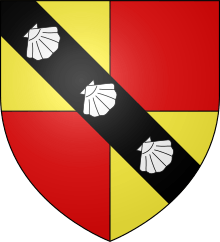William Eure, 2nd Baron Eure
William Eure, 2nd Baron Eure (10 May 1529–12 September 1594) was a Tudor-era English nobleman, soldier, and official in the Scottish Marches.
William Eure | |
|---|---|
| 2nd Baron Eure | |
 Arms of the Eures of Witton | |
| Born | 10 May 1529 |
| Died | 12 September 1594 |
| Noble family | Eure |
| Spouse(s) | Margaret Dymoke |
| Father | Ralph Eure |
| Mother | Margery Bowes |
Family
William Eure was the son of Ralph Eure, eldest son of William Eure, who had been created Baron Eure in 1544, and Margery Bowes, daughter of Ralph Bowes of Streatlam Castle. His father died at the Battle of Ancrum Moor in 1545, leaving William as the heir to his grandfather's peerage.[1] He was appointed Vice-Admiral of the coast of County Durham and Vice-Admiral of Yorkshire by Lord High Admiral Clinton in 1563.[2]
The Scottish Marches
Like his father and grandfather before him, Eure spent much of his life in the borderlands of Scotland and England. Sometime before 1557, he was appointed, jointly with Thomas Wharton, Captain of Berwick Castle, and he served under the Earl of Sussex in his 1570 invasion of Scotland. He was later dispatched with the Earl of Rutland to negotiate a peace treaty with Scotland in 1587.[3]
Marriage and children
Eure had been contracted to marry Mary Darcy, daughter of George, Lord Darcy, when he was 11 years old (his prospective wife-to-be was age 4 at the time). At some point after 1544, he repudiated this marriage contract and instead married Margaret Dymoke, daughter of Edward Dymoke of Scrivelsby, Champion of England.[4] They had five sons and six daughters:[3]
- Ralph, who succeeded as the 3rd Baron Eure
- Francis, MP, ancestor of the 7th and 8th Barons
- William
- Charles
- Charles (a second of the same name)
- Anne, who married John Mallory
- Meriol, who married Richard Goodricke
- Martha, who married William Armyne
- Mary
- Margaret
- Elizabeth
Margaret Eure predeceased her husband, dying in 1591, and was buried 15 September 1591 at Ingleby, Lincolnshire.[4]
Death and succession
Eure died on 12 September 1594 and was buried at Ingleby the next day. He was succeeded in his peerage by his eldest son, Ralph.
References
- Burke, Bernard, "Genealogical History of the Dormant, Abeyant, Forfeited, and Extinct Peerages of the British Empire, pp. 190-1
- Institute of Historical Research
- Lodge, Edmund, "Illustrations of British History, Biography, and Manners" pp. 390-2
- Furnivall, Frederick James, "Child Marriages, Divorces, and Ratifications", pg. 24